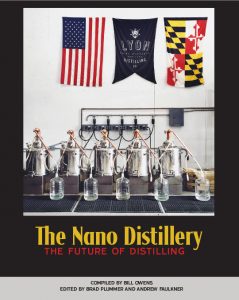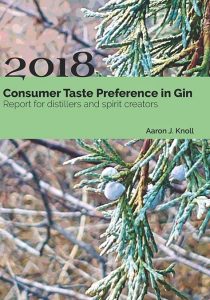 The Nano Distillery: The Future of Distilling
The Nano Distillery: The Future of Distilling
Compiled and edited by Brad Plummer and Andrew Faulkner
(Hayward: White Mule Press, 2018)
148 pages
$25.00
ISBN: 9781732235403
New from ADI’s White Mule Press, The Nano Distillery is a must read for anyone thinking of opening a distillery no matter the size. The book compiles essays written mostly by distillers who are currently running nano distilleries (a distillery that removes less than 10,000 proof gallons from bond) and was organized and edited by Bill Owens, Brad Plummer and Andrew Faulkner. The book is set in four parts: things to consider before becoming a distiller; the basic regulations, construction and operation of a distillery; production techniques specific to whiskey and gin; and profiles of 34 nano distilleries.
While some may assume that opening a successful distillery is financially out of their reach, The Nano Distillery demonstrates that success can be had with a small initial investment. As the writers explain, sustaining a craft distillery takes not only determination and hard work but also the right location and business model for your state and municipality. Opening a distillery is more than just buying some equipment and starting to make booze. The 10 questions offered at the beginning of part one may seem simple at first glance, but they emphasize that it is worth taking the time to fully understand your own motivations for starting a distillery as well as what it will take to make that happen.
The Nano Distillery offers some whiskey, gin, rum and RTD product ideas that given the right environment can turn a few thousand dollars in raw materials into tens of thousands of dollars in revenue generated through sales by the glass and by the bottle. In the end, if you’ve read the book, done your homework and you still want to open a distillery, you’ll be equipped to just do it.
 Consumer Taste Preference in Gin: 2018 Report for Distillers and Spirit Creators
Consumer Taste Preference in Gin: 2018 Report for Distillers and Spirit Creators
Aaron J. Knoll, (n.p.: Author, 2019)
56 pages
$49.00
ISBN: 9781793383495
Aaron Knoll is the author of several books on gin, including The Craft of Gin, which he co-authored with David T. Smith; and Gin: The Art and Craft of the Artisan Revival, which has been translated into six languages. He is also the author of the spirits blog, the “The GIN is IN,” and has served as a gin judge for ADI and the World Gin Awards. Knoll’s latest book, Consumer Taste Preference in Gin: 2018 Report for Distillers and Spirit Creators, takes a data-driven look at the taste preferences of gin consumers.
The book is an analytical breakdown of the aggregated search terms entered by gin enthusiasts who visited the “The GIN is IN” website between August 2017 and November 2018. Knoll developed a Gin Flavor Diagram in 2012 to serve as simple visual representation of the intensity and flavor profile of the gins he’s reviewed. The flavor diagram also serves as a search tool for readers and gin drinkers to select their ideal flavor profile and find gins that match or are similar. Given that the “The GIN is IN” is one of the most popular dedicated gin sites on the internet, we can be certain that the opinions of Knoll’s gin community are worth paying attention to.
From his data Knoll explores several important questions: What are the preferred gin profiles? Does the time of year affect taste preferences for gin? What gin taste preferences cross over one to another? What flavor gaps exist in the market? What trends can be found in the data?
As the subtitle indicates, the book is meant as the first in a series of reports for distillers and producers to better understand what gin drinkers are looking for. It is one thing to look at sales figures and say, “Brand X with these botanicals is doing well — we should mimic that,” or even, “We should go in the opposite direction.” But that is not the same as asking, “What do gin drinkers want?” The data and analysis that Knoll has pulled together from thousands of gin enthusiasts begins to address this question. This book is a good resource whether you are developing a new gin or you are looking for new or better ways to communicate with consumers.








